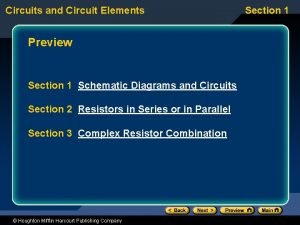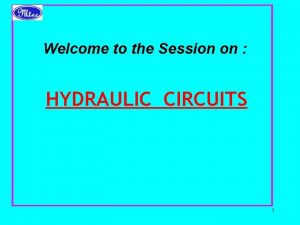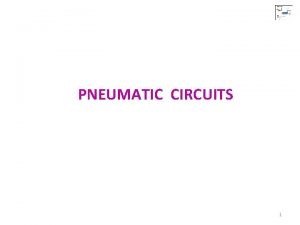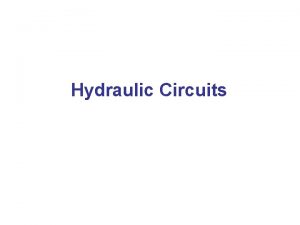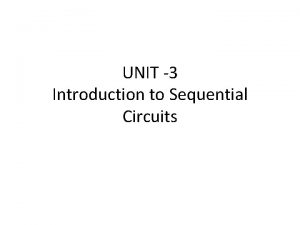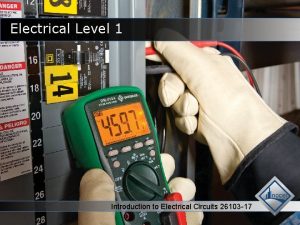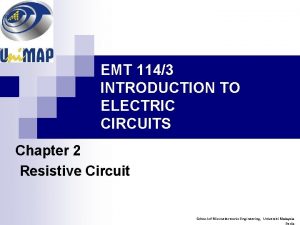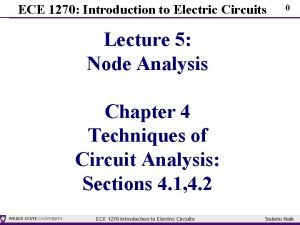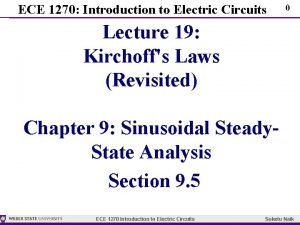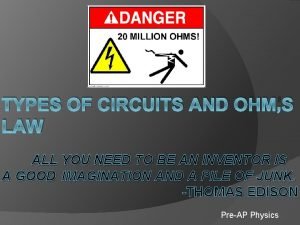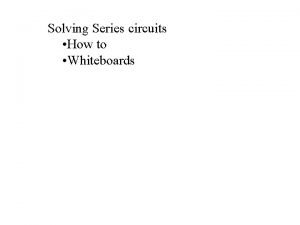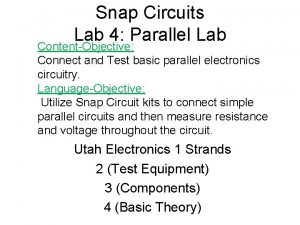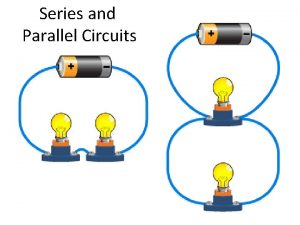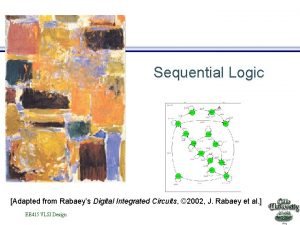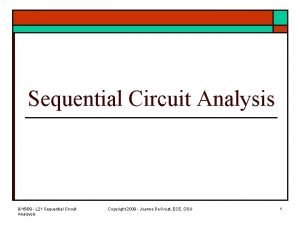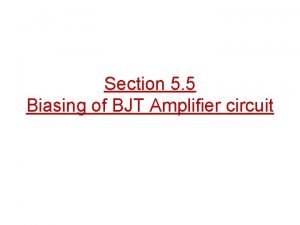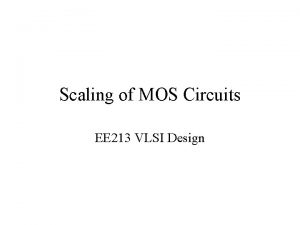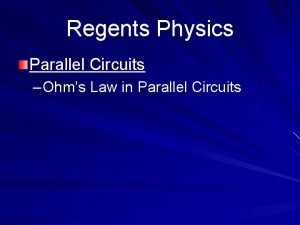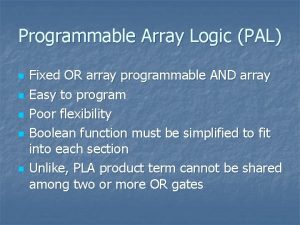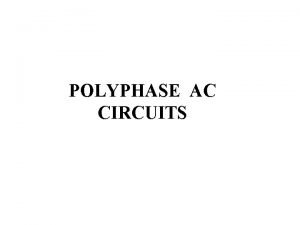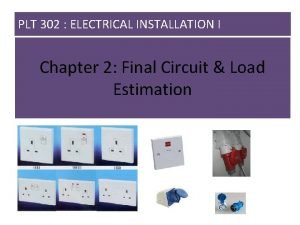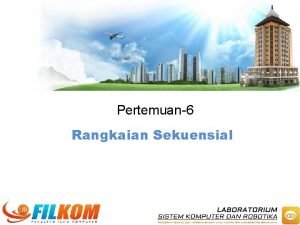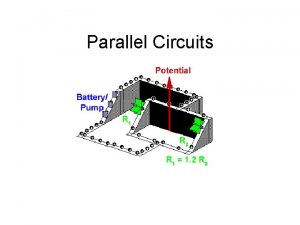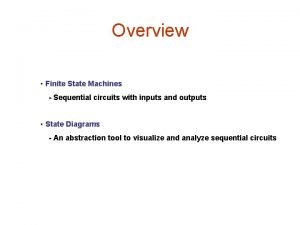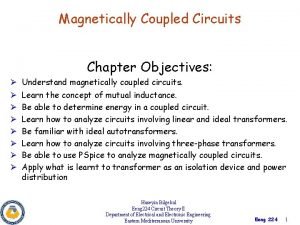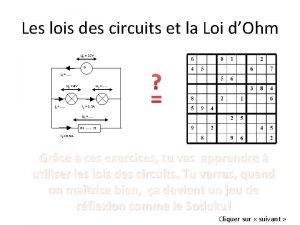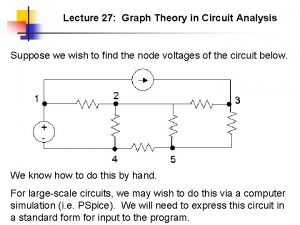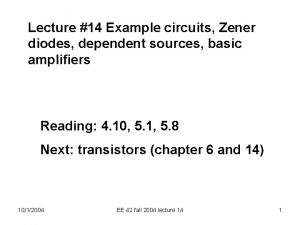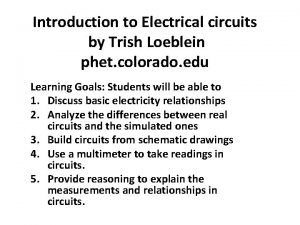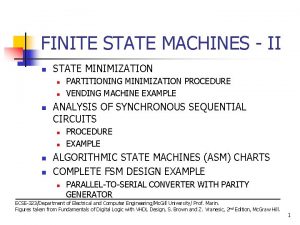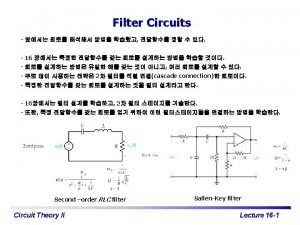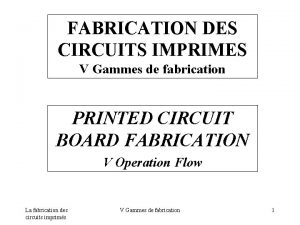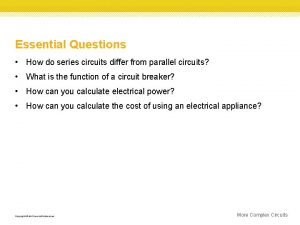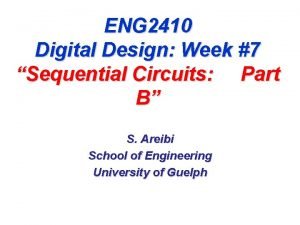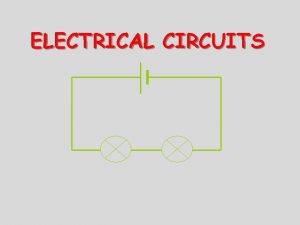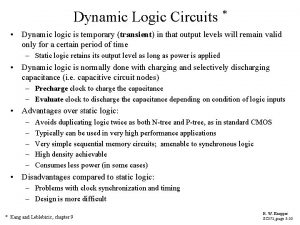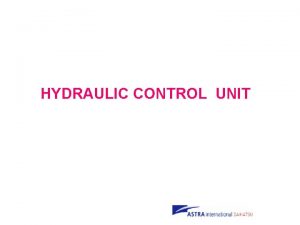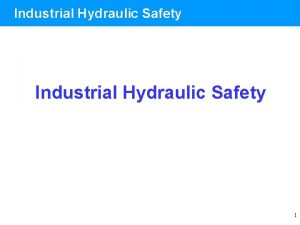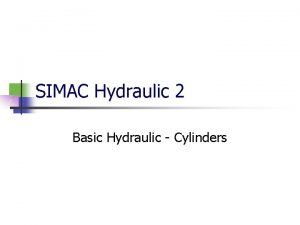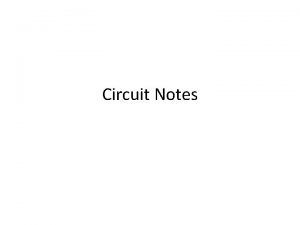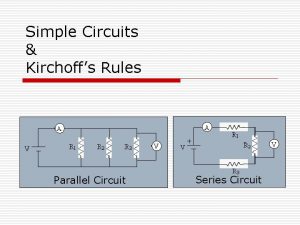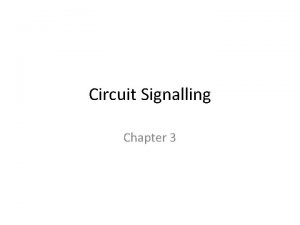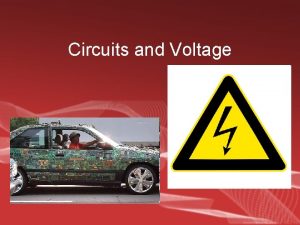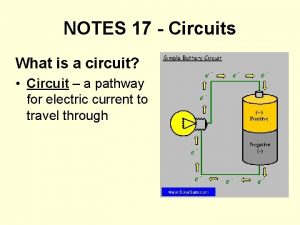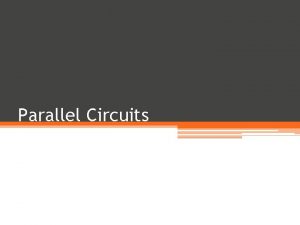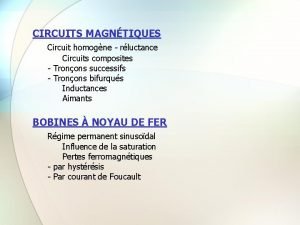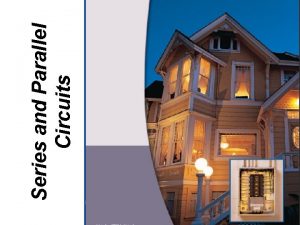Hydraulic Circuits Introduction A hydraulic circuit is a

























































- Slides: 57

Hydraulic Circuits

Introduction § A hydraulic circuit is a group of components including one or more pump, actuators, valves, piping, and ancillary equipment. It is used for power transmission and control. Hydraulic Valve Hydraulic Cylinder Vx. I Electric Motor Txω Fxv Hydraulic Pump Px. Q Hydraulic Motor Txω

Hydraulic Circuits § § § § § Single Acting Hydraulic Cylinder Control Circuit Double Acting Hydraulic Cylinder Control Circuit Regenerative Cylinder Circuit Pump Unloading Circuit Double Pump Circuit Counterbalance Valve Circuits Cylinder Sequencing Circuits Locked Cylinders using Pilot Check Valves Cylinder Synchronization Circuits Fail Safe Circuits

Single Acting Hydraulic Cylinder Control Circuit

Single Acting Hydraulic Cylinder Control Circuit

Single Acting Hydraulic Cylinder Control Circuit

Single Acting Hydraulic Cylinder Control Circuit

Single Acting Hydraulic Cylinder Control Circuit

Single Acting Hydraulic Cylinder Control Circuit

Single Acting Hydraulic Cylinder Control Circuit

Single Acting Hydraulic Cylinder Control Circuit

Single Acting Hydraulic Cylinder Control Circuit

Single Acting Hydraulic Cylinder Control Circuit

Single Acting Hydraulic Cylinder Control Circuit

Single Acting Hydraulic Cylinder Control Circuit

Single Acting Hydraulic Cylinder Control Circuit

Single Acting Hydraulic Cylinder Control Circuit

Single Acting Hydraulic Cylinder Control Circuit

Single Acting Hydraulic Cylinder Control Circuit

Single Acting Hydraulic Cylinder Control Circuit

Single Acting Hydraulic Cylinder Control Circuit

Single Acting Hydraulic Cylinder Control Circuit

Single Acting Hydraulic Cylinder Control Circuit

Single Acting Hydraulic Cylinder Control Circuit Analysis Objectives Given: • Load carrying capacity • Extension speed • Retraction speed What are the objective of design analysis?

Single Acting Hydraulic Cylinder Control Circuit Analysis Objectives § Pump § Flow rate § Pressure Head § Type § Pressure Relief Valve § Cracking pressure § Full Open pressure § Size § Spring § Stiffness § Initial Compression

Single Acting Hydraulic Cylinder Control Circuit Design Optimization What are the objective of design optimization?

Single Acting Cylinder Control Circuit Design Optimization § § § Improve efficiency (operating cost) Reduce size and weight Increase safety Reduce cost Simplify operation Improve functionality § Allow to stop during stroke § Allow servo control § Increase retraction speed § …. . Extend working life Reduce noise Improve reliability Reduce pollution and environmental effects …

Double Acting Cylinder Control Circuit Extend Hold Retract

Double Acting Cylinder Control Circuit Extend Hold Retract

Automatic Cylinder Reciprocating System § Two sequence valves sense a stroke completion by corresponding buildup of pressure. Each check valve and corresponding pilot line prevents shifting of the directional control valve until the particular stroke of the cylinder has been completed. § The check valves are needed to allow pilot oil to leave either end of the DCV while pilot pressure is applied to the opposite end. This permits the spool of the valve to move as required.

Automatic cylinder Reciprocating System





Flow and pressure analysis in the automatic reciprocating cylinder § During the extension stroke, the speed of the piston is determined by the flow rate out of the pump, and the area of the blank -end of the piston. § Assuming constant piston speed, and resistive load on the piston, (load resisting the extension), the pressure on the rod end of the piston (gauge pressure) is equal to the pressure loss in the return line connecting the outlet port to the tank. § For a straight circular pipe, the pipe flow coefficient, K pipe is: f is the friction factor for the pipe. For fully turbulent flow, f is a function of the pipe’s relative roughness. In the transition region, f is a function of the relative roughness and Re. It is determined from the Moody diagram.

Flow and pressure analysis in the automatic reciprocating cylinder § The pressure on the blank end is determined by the pressure on the rod side and the load




Double Pump Hydraulic System

Double Pump Hydraulic System § A high-pressure, low-flow pump works in conjunction with a lowpressure, high-flow pump. A typical application is a sheet metal punch where high force and pressure requirements occur during a short motion portion of the hydraulic cylinder when the punching operation occurs. § During the punching operation, the cylinder travel is small, and thus the flow-rate requirements are low. The circuit eliminates the necessity of having a very expensive high pressure, high flow pump

Double Pump Hydraulic System § Before the punching operation begins, the rapid extension of the piston is provided by both pumps operating at low pressure outlet (pressure is determined by the load). The flow of the high-flow pump goes through the check valve to the hydraulic cylinder. § Near the end of the cylinder stroke the punching operation begins and the increased pressure opens the unloading valve to unload the highflow pump. The check valve protects this pump from the high pressure generated by the high-pressure pump.

Analysis of a Double Pump Circuit § The gauge pressure on the rod end of the piston is equal to the pressure loss in the return line connecting the outlet port to the tank. § During the rapid extension, the flow rate is high and the rod-end pressure will be significant. The blank-end pressure, pb, ext is given by: § During the punching operation, the flow rate is small, and the rod-end pressure is negligible. The blank-end pressure is determined by the punching load: § The pressure calculated above may be used to determine the settings of the unloading valve, ps, uv. For example, we could set it to be equal to 1. 5 times pb, ext § The pressure calculated above may be used to determine the settings of the pressure relief valve, ps, rv. For example, we could set it to be equal to 1. 5 times pb, punxh

Fail-Safe Circuits

Protection from Inadvertent Cylinder Extension § The circuit utilizes a pilot operated check valve to prevent the cylinder from falling in the event of hydraulic line rupture or pump failure. The valve also provides protection in case someone inadvertently operates the manual override on the pilot actuated directional control valve when the pump is not operating.

Protection from Inadvertent Cylinder Extension § This design also allows the upper directional control valve to be placed at a distant location from the machine. The lines connected to the valve are basically for sensing. Flow and pressure (high power lines) go though the bottom DCV, which acts in a manner similar to relay.

Protection from Inadvertent Cylinder Extension § This design also allows the upper directional control valve to be placed at a distant location from the machine. The lines connected to the valve are basically for sensing. Flow and pressure (high power lines) go though the bottom DCV, which acts in a manner similar to relay.

Fail Safe with Overload Protection § Directional Control Valve 1 is controlled by the pushbutton, three-way DCV 2. If the cylinder experiences excessive resistance during its extension stroke, the sequence valve pilot actuates the overload DCV 3. § This drains the pilot line of DCV 1, causing it to return to its spring-offset mode. If an operator then tries to push DCV 2, nothing happens unless DCV 3 is manually shifted to its blocked port configuration. Thus the system components are protected from excessive load during the extension stroke. Sequence Valve DCV 3 DCV 2 DCV 1

Two-Handed Safety System § For the circuit to extend, the operator must depress both manually actuated valves via the push button. § When the two buttons are depressed, the main DCV is pilotactuated to extend the cylinder. When one of the pushbuttons is released, the cylinder retracts.

Two-Handed Safety System

Two-Handed Safety System

Two-Handed Safety System

Two-Handed Safety System

Two-Handed Safety System

Two-Handed Safety System

Two-Handed Safety System
 Advantages of parallel circuits over series circuit
Advantages of parallel circuits over series circuit Circuits and circuit elements
Circuits and circuit elements Hydraulic circuit for drilling machine
Hydraulic circuit for drilling machine Impulse operation circuit in pneumatics.
Impulse operation circuit in pneumatics. Series hydraulic circuit
Series hydraulic circuit Introduction to sequential circuits
Introduction to sequential circuits Nccer introduction to electrical circuits
Nccer introduction to electrical circuits Introduction to electric circuits
Introduction to electric circuits Find vx
Find vx Ece
Ece Parallel circuit vs series circuit
Parallel circuit vs series circuit Types of electrical circuits
Types of electrical circuits Parallel circuit circuit construction kit
Parallel circuit circuit construction kit Series vs parallel circuit
Series vs parallel circuit Complete vs incomplete circuit
Complete vs incomplete circuit Short circuit in physics
Short circuit in physics Concept map
Concept map The circulatory system
The circulatory system Lesson outline lesson 3 describing circuits answers
Lesson outline lesson 3 describing circuits answers Difference between virtual circuit and datagram
Difference between virtual circuit and datagram Types of circuits and ohms law
Types of circuits and ohms law Spinal cord
Spinal cord Special-purpose op-amp circuits
Special-purpose op-amp circuits Solving series circuits
Solving series circuits Snap circuits lab
Snap circuits lab Facts about series and parallel circuits
Facts about series and parallel circuits Non bistable sequential circuits
Non bistable sequential circuits Sequential circuit analysis
Sequential circuit analysis Bjt amplifier biasing
Bjt amplifier biasing Scaling factors for device parameters in vlsi
Scaling factors for device parameters in vlsi Parallel circuit laws
Parallel circuit laws Programmable array logic circuit
Programmable array logic circuit Polyphase ac
Polyphase ac Ckt motor perlis
Ckt motor perlis Contoh rangkaian sekuensial
Contoh rangkaian sekuensial Parallel circuit examples
Parallel circuit examples Finite state machine sequential circuits
Finite state machine sequential circuits Neural circuits the organization of neuronal pools
Neural circuits the organization of neuronal pools Microelectronic
Microelectronic Magnetic coupling transformer
Magnetic coupling transformer Lois dohm
Lois dohm Abdcefgh
Abdcefgh Circuits with dependent sources
Circuits with dependent sources Phet electric circuits
Phet electric circuits Difference between parallel and series connection
Difference between parallel and series connection Neuronal pool
Neuronal pool Fundamentals of electric circuits chapter 4 solutions
Fundamentals of electric circuits chapter 4 solutions Asm chart for vending machine
Asm chart for vending machine Frequency selective circuit
Frequency selective circuit Poinçonnage
Poinçonnage How do series and parallel circuits differ
How do series and parallel circuits differ Analysis of sequential circuits
Analysis of sequential circuits Type of circuit
Type of circuit Circuits activator answer key
Circuits activator answer key Parallel circuit examples
Parallel circuit examples Electric current
Electric current Dynamic logic circuits
Dynamic logic circuits Jan m rabaey digital integrated circuits
Jan m rabaey digital integrated circuits

